The people of Sikkim love to eat and they cook some of the most delicious items available in north-east with momo being one of the most popular ones. Sikkim food primarily consist of noodles, thukpas, soups and other fermented dishes owing majorly to its very cold climate.
The food of the people of Sikkim reflects the culture of the state which is a blend of Nepal, India, Bhutan and Tibet. Rice is the staple food of the people of the state. Meat and dairy products also form a part of their daily meal. Generally fermented food, vegetables and beverages are very much liked by the people. The people grow crops like finger millet, wheat, buckwheat, barley, vegetable, potato, soybeans, etc. By the process of fermentation the people are able to preserve lot of non seasonal vegetables also and this is quite traditional. The cuisine of the Sikkimese mainly comprises of Dals (lentils), fresh vegetables, bamboo shoots, wild flowers, mushrooms and nettle leaves. They prefer non- vegetarian food like beef, pork and fish. Alcohol is very common among the people of Sikkim. An assortment ofsoups, pickles and beverages make the Sikkim cuisine more flavorsome and delicious. Some of the common dishes preferred by the people are Momos or steamed dumpling, Tomato Achar Pickle, Noodle soup, Fermented soybean, Fermented vegetable soup, Traditional cottage cheese, Chhurpi-Ningro Curry, Fermented rice product, String bean pickle, Mutton curry and Fermented bamboo shoot.
. 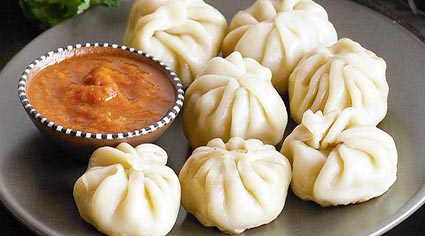
|
|
The men belonging to the Lepcha community wear a white pajama, stretching to the calves and this is called as Thokro-Dum. The men wear a shirt and a cap commonly known as Yenthatse and Shambo respectively. The costume of Bhutia men is similar to that of the Lepcha which is known as Bakhu which is like a long robe and tied to the neck on one side and with a silk or a cotton belt at the waist. On top of all this they prefer a waist coat, Jya Jya. Nepalese constitute a portion of the population of the people of Sikkim and their origin is very clearly depicted in their attires. The Nepalese men dress themselves in Shurval, a Churidar Pajama, topped off by a shirt, known as Daura. The women of Lepcha community drape themselves with a smooth and cozy dress which is quite long and goes up to the ankle. The blouse worn by them is very loose and is known as Tago. Apart from this they wear a belt and a cap and adorn themselves with earrings, called Namchok, Lyak a necklace, Gyar and a bracelet. The costume of the Bhutia women is more or less similar to that of the Lepcha's. The married women of this community apart from their regular costume wear a stripy apron known as Pangden.They are quite crazy about gold ornaments. The women belonging to the Nepali community adorn themselves with vibrant colours especially the saris. The blouse is loose and is fastened from four sides and hence is called ChaubandiCholo.The upper portion of the body is daintily enveloped with a piece of cloth with wonderful prints. It is called Hembari.
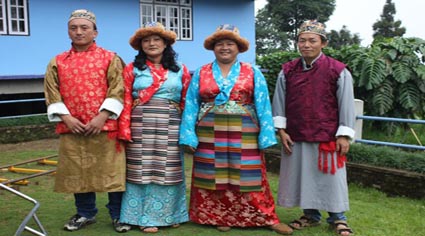
|
|
Folk dances and songs are an ingrained part of Sikkimese culture. Most of the dances related to the amazing beauty of the natural surroundings, some signifies the harvest season and others are performed for prosperity. Many of the musical instruments that accompany the dances are unique to Sikkim. Almost all the dances are accompanied by the musical instruments. Some of the popular dances are described below :
The Dances accompanied with Songs and Music
Lu Khangthamo
It is dedicated to this day - a day of thanks giving to all Gods and deities of the three worlds, Heaven, Earth and Hell. This age old folk dance is performed regularly by the young and old folk alike in their traditional customs and ornaments accompanied by the pleasing song and music on the occasion like warming and New Year celebrations. It is a Bhutia folk dance.
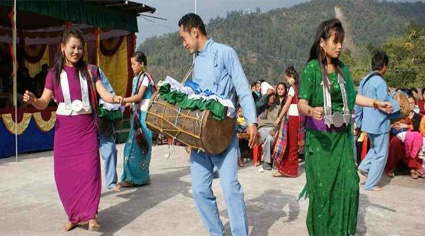
|
|
Those who have lived in Sikkim long enough will testify that life here is, in a sense, an ongoing festival. In one way or the other there are festivals and festivities throughout the year. This is a reflection of the rich cultural heritage of Sikkim. A cultural heritage which combines the flamboyant aspects of Vajrayana Buddhism and the equally splendid features of Hinduism with the original animist traditions of the Lepchas.
What makes the festivals and festivities of Sikkim more than just dry religious rituals is the communal participation. It is not an uncommon sight to see the Hindu population or those from other parts of India, in the monasteries watching and enjoying the lama dances or the other Buddhist ceremonies; just as it is fairly common to see the Lepchas and Bhutias celebrating Dasain and Dipavali (festival of lights) with their Hindu friends. For those visiting Sikkim the festivals of this place offer a unique opportunity to participate and sample the rich traditions of an ancient culture ; as well as the warmth and hospitality of a friendly people.
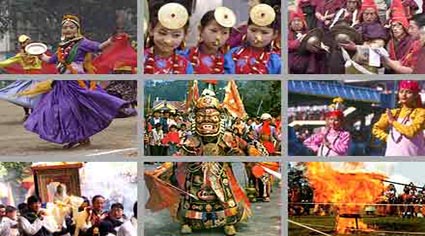
|
|
On any religious festival and occasions the monks of the temple cover themselves with masks, ceremonialswords and sparkling jewels dance according to the rhythm of resounding drum and trumpeting of horns. The people of Sikkim who follow the Mahayana form of Buddhism celebrate the festival of Saga Dawa which is supposed to very auspicious. On this particular day the people go the monasteries and worship offering butter lamps. There are also processions arranged by the monks and they go around the town of Gangtok reading and singing the Holy Scriptures. As a matter of offering thanks to Mount Kanchendzonga which is considered to guard the state of Sikkim, the festival of Phang Lhabsol is celebrated with great pomp.
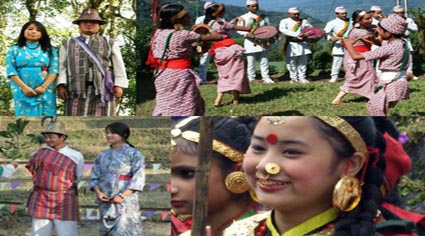
|
|
Sikkim is renowned for its dazzling and appealing beauty. The charm of this state is ever enticing and no one can remain abstain from its allure. In fact, Sikkim is resplendent with not only its natural beauty but with its art and craft too. The cultural richness of Sikkim is visible in its quality handicrafts.
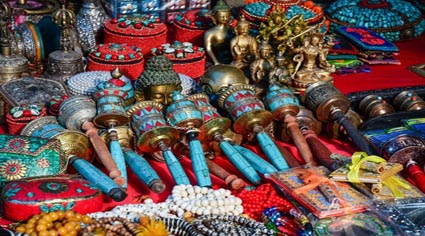
|
|







